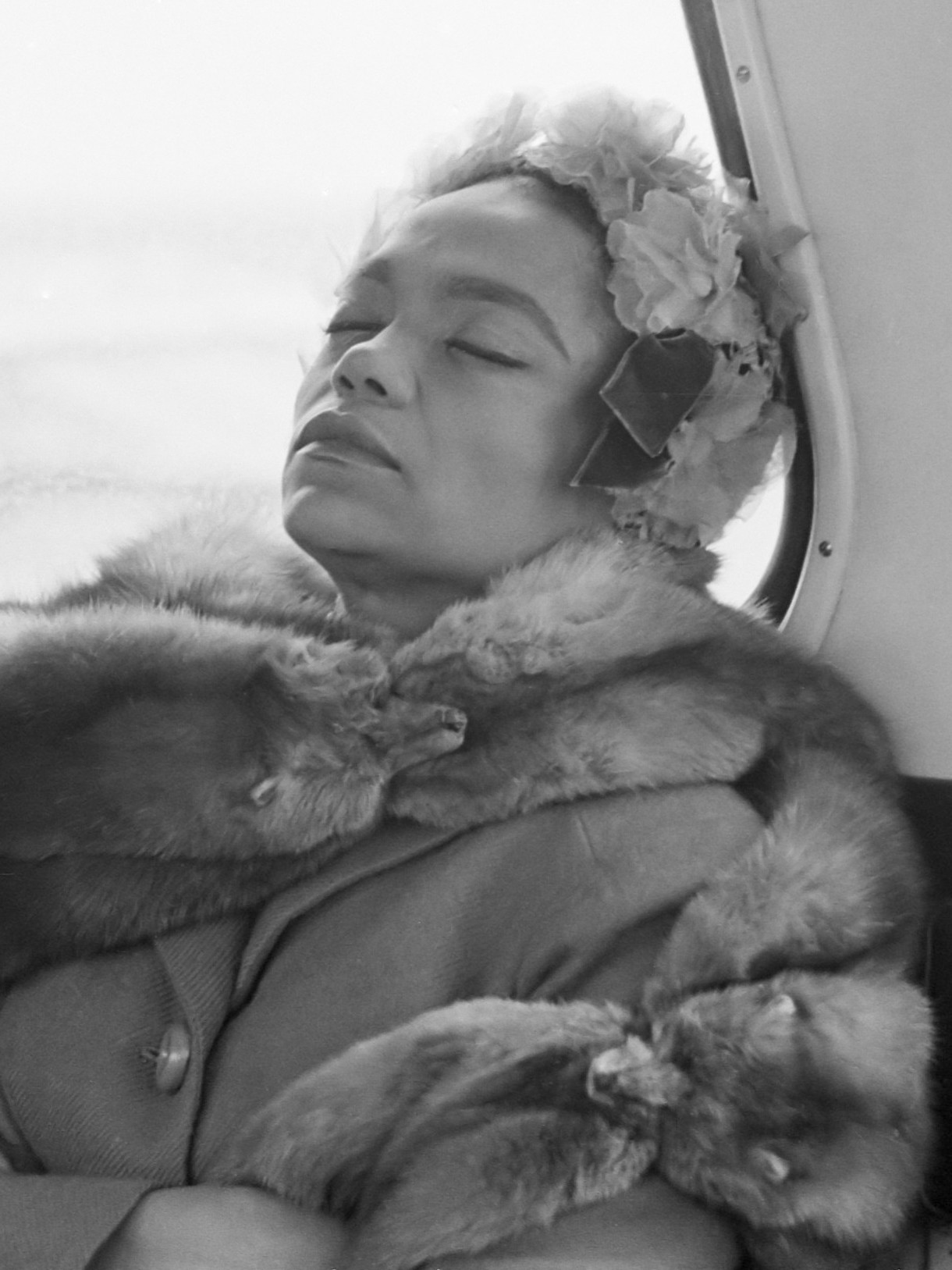Whenever “Santa Baby” plays during the holiday season, it’s a crucial opportunity to introduce everyone to the song’s incredibly underrated originator, Eartha Kitt. While many recognize “Santa Baby” as a festive classic, Eartha Kitt’s musical contributions are far more extensive and profound. She was not only an internationally acclaimed actress and civil rights advocate but also a captivating singer whose songs mirrored her dynamic life and persona.
Beyond her iconic portrayal of Catwoman and voicing Yzma in The Emperor’s New Groove, Eartha Kitt’s music career deserves equal spotlight. Orson Welles famously declared her “the most exciting woman in the world,” while the CIA considered her a threat. For many, she embodies triumph, resilience, and stands as a cultural icon of feminism, sex positivity, and the fight for civil rights. “Santa Baby” is just the tip of the iceberg; Eartha Kitt’s songs reveal a much richer and more complex artistic legacy.
From Cotton Fields to Center Stage: The Early Life Shaping Eartha Kitt’s Music
Born on a cotton plantation in South Carolina, Eartha Kitt’s early life was marked by hardship and a search for belonging, experiences that profoundly influenced her artistic expression. Never knowing her father and abandoned by her mother at a young age, Kitt endured abusive conditions in her adoptive family, laboring in cotton fields. She described the pain of being biracial, feeling “not black enough to belong to the blacks, and not white enough to belong to the whites,” a sentiment of marginalization that would resonate in the emotional depth of many Eartha Kitt Songs.
Around the age of eight, her biological aunt took her to Harlem, though Kitt described the move as motivated more by “Christian duty” than affection. During her adolescence, she worked in a sewing machine factory and frequently sought refuge in subway cars, escaping a difficult home life. At 21, a pivotal audition with Katherine Dunham’s pioneering African-American dance company changed her trajectory. This marked the beginning of her journey in entertainment and laid the foundation for her future music career.
Her travels with the Katherine Dunham Company through New York, London, and Paris exposed her to diverse audiences and artistic influences. It was in Europe that she encountered Orson Welles, who was so captivated by her performance that he cast her as Helen of Troy in Dr. Faustus. While their relationship, as she recounts in her autobiography Confessions of a Sex Kitten, was an affair, she emphasized its non-sexual nature, stating, “The most exciting men in my life have been the men who have never taken me to bed.” This quote reveals a facet of Kitt’s understanding of intimacy and connection that may also be subtly explored in some of her song interpretations.
 Eartha Kitt in 1962. Photo via Wikimedia Commons
Eartha Kitt in 1962. Photo via Wikimedia Commons
“Santa Baby” and the Rise of a Sultry Songstress
Within three years of these experiences, Eartha Kitt released her first album, featuring “Santa Baby.” This song not only became a holiday staple but also trademarked her unique raw, sexual energy and signature purr in her vibrato, elements that defined many Eartha Kitt songs. The New York Times described her as being “known for her sultry voice, her persona as a golddigger who renders men into helpless little boys with her sexual power.” Kitt embraced this persona, seemingly enjoying being perceived as “bad,” desirable, and empowered by her sexuality. “Santa Baby,” with its playful requests for extravagant gifts, perfectly embodies this image of a woman confidently wielding her charm and desires, a theme present in various Eartha Kitt songs that explore themes of love, desire, and independence.
However, in the 1950s and 60s, sex positivity, especially for a Black woman, was a radical concept. Eartha Kitt emerged as a sex symbol in a postwar America grappling with evolving social norms. This was a time when Marilyn Monroe’s popularity was controversially viewed, and the sexual revolution was just beginning to gain momentum. Simultaneously, the Civil Rights Movement was in full swing, and African Americans were fighting for basic human rights in a deeply segregated nation.
In 1966, during the zenith of her early career, polls indicated that a majority of white Americans felt racial equality was progressing “too quickly.” Eartha Kitt’s ascent defied both racial and gender expectations of the era, making her songs and performances inherently provocative and boundary-pushing. Her music, in this context, became an act of defiance, subtly challenging societal norms through her persona and performance style.
Catwoman and Continued Musical Success
In 1967, Kitt took on the role of Catwoman in the Batman TV series, further cementing her iconic status. Her portrayal, clad in a sexy leather suit and punctuated by her signature purring, was groundbreaking for Black female representation. JET magazine, at the time, highlighted the limited visibility of Black individuals on television, making Kitt’s prominent role even more significant.
Beyond representation, Kitt’s Catwoman challenged stereotypes of Black women in media. As Professor Deborah Elizabeth Whaley argues, Kitt “did not fit the proverbial mammy, Jezebel, tragic mulatta, and sapphire stereotypes that were abundant on television and in the cinema at this time.” This subversion of stereotypes extended to her music, where she often presented complex female characters and narratives beyond conventional tropes in Eartha Kitt songs.
While her acting career soared with Batman, Eartha Kitt continued to produce music, enriching her repertoire with songs that explored themes of love, loss, and social commentary. Although “Santa Baby” remained her most commercially recognized song, her albums showcased a diverse range of styles and emotional depth, further solidifying her reputation as a versatile artist.
 Eartha Kitt as Catwoman in 1967. Photo via Wikimedia Commons
Eartha Kitt as Catwoman in 1967. Photo via Wikimedia Commons
Political Stand and Career Setback: The Vietnam War Controversy
In January 1968, Eartha Kitt’s career trajectory faced a dramatic shift following her outspoken stance at a White House luncheon on juvenile crime. Invited by First Lady Lady Bird Johnson due to her work with inner-city youth, Kitt was among a small number of Black women present. While other speakers focused on superficial beautification projects, Kitt used her platform to vehemently denounce the Vietnam War.
Witnessing what she perceived as tone-deaf discussions about “flower pots on the windowsills of poverty,” Kitt felt compelled to speak from her own experience. “I have lived in the gutters,” she declared, “That’s why I know what I’m talking about.” She passionately articulated the connection between the war and domestic unrest, stating, “You send the best of this country off to be shot and maimed… They rebel in the street… They don’t want to go to school because they’re going to be snatched off from their mothers to be shot in Vietnam.” Her powerful words reportedly brought Lady Bird Johnson to tears.
The immediate aftermath was palpable. Kitt was left without transportation from the White House and learned from radio reports that the dominant narrative was “Eartha Kitt made Mrs. Johnson cry,” framing her as an antagonist. This incident triggered severe repercussions, impacting not only her public image but also her career in the United States.
CIA Dossier and Career Exile
Within days, the CIA compiled a dossier on Eartha Kitt at President Johnson’s request, drawing upon information gathered since 1956. This report, filled with secondhand gossip, alleged scandalous behavior, a “vile tongue,” and infamously labeled her a “sadistic nymphomaniac.” This derogatory label would haunt her for years, appearing in media coverage and contributing to a significant downturn in her career within the US.
Despite her continued artistic output and the enduring appeal of Eartha Kitt songs, she faced professional blacklisting in America. Nightclubs and venues stopped booking her, and she lost her contract with WME. Forced to perform primarily in Europe, Kitt continued to tour and engage with audiences abroad. It wasn’t until six years later, through a New York Times report, that she fully understood the extent of the CIA’s smear campaign and its devastating impact on her career.
Resilience, Comeback, and Lasting Legacy of Eartha Kitt Songs
Despite the career setback, Eartha Kitt demonstrated remarkable resilience. She eventually made a triumphant return to Broadway, starred in films, and received Tony and Grammy nominations, proving her enduring talent. She was even invited back to the White House by President Jimmy Carter, signaling a degree of rehabilitation in her public image.
Her refusal to compromise her beliefs, though costly, became a defining aspect of her iconic status. Throughout her life, Eartha Kitt remained steadfast, consistently defending her White House statement. She continued her activism, supporting underprivileged youth and advocating for peace and freedom. Her unapologetic embrace of her sexuality persisted into her later years, as evidenced by her famous interview where she playfully challenged the interviewer about her “wickedness.”
Eartha Kitt’s perspective on relationships, famously articulated in the documentary All By Myself, encapsulates her self-assuredness: “Compromising for what reason? To compromise for what? To compromise? What is compromise?” she questioned. “A man comes into my life and I have to compromise? You must think about that one again… A relationship is a relationship that has to be earned!” Her philosophy of self-love and partnership resonated with her independent spirit, mirrored in the themes of strength and autonomy often found in Eartha Kitt songs.
Eartha Kitt’s legacy extends beyond “Santa Baby.” Her songs are a testament to her multifaceted artistry, reflecting her journey from poverty to international stardom, her fearless activism, and her unapologetic individuality. Exploring Eartha Kitt songs is to discover a rich tapestry of musical expression that embodies the spirit of a true iconoclast.

